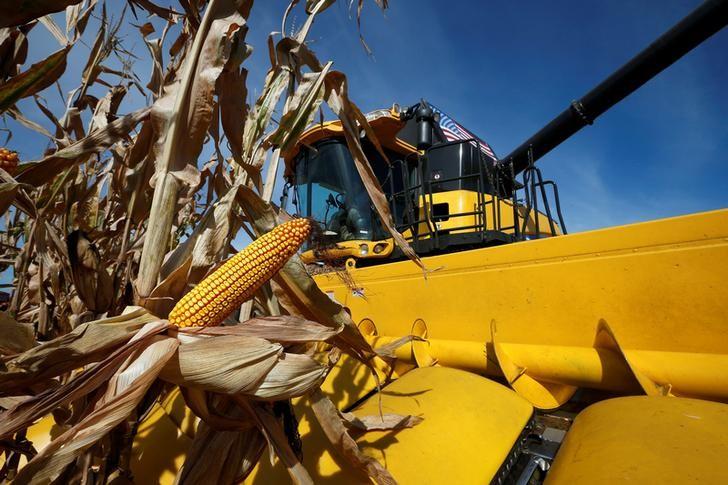Reuters: U.S. farmers tighten belts to compete with cheap LatAm grain

FILE PHOTO: A combine machine harvests corn in a field in Minooka, Illinois, September 24, 2014. REUTERS/Jim Young/File Photo
by Mark Weinraub, P.J. Huffstutter | October 25, 2017
CHICAGO (Reuters) – When Kansas farmer Tom Giessel drove over a deer carcass and punctured a tire on his combine during harvest this fall, he did not have the time or cash to fix it. He borrowed his neighbor’s combine to finish.
U.S. farmers are cutting costs any way they can to compete against cheaper producers in Argentina and Brazil. Four years of global oversupply have pushed down grain prices, reduced agricultural revenues and put more expensive producers under financial pressure.
In response, U.S. farmers have bought cheaper seeds, spent less on fertilizers and delayed equipment purchases as they seek to ride out the downturn. But more bumper harvest forecasts and rising energy prices herald another tough year for farmers in 2018.
“The logical thing to do is stop farming,” said Giessel, 64, who farms about 5,000 acres and has worked on the land all of his adult life.
Giessel has cut spending on what he can control – seeds, chemicals, fertilizer, rented land – and chewed through his farm’s savings. He stands to lose $93 an acre, or nearly $15,000, on one corn field alone this year.
“My burn rate is a raging fire. And I am no different than anyone else out here,” Giessel said.
Some farmers have had to sell assets to keep afloat. Others have gone into bankruptcy.
U.S. farmers have taken another hit this year because of rising prices of labor, fuel and electricity. Those costs together account for about 14.5 percent of total expenses and are largely out of farmers’ control. Interest expenses have also risen as banks have tightened credit to the agricultural sector.
These items were expected to push overall costs up 1.3 percent in 2017, which would mark the first year since 2014 that farmers have failed to reduce total costs.
Farmers cut $40.20 billion to bring total costs down to $350.49 billion between 2014 and 2016, according to the U.S. Agriculture Department’s Economic Research Service.
The downturn in spending has hurt farm equipment manufacturers.
Sales in the agriculture division at Deere & Co (DE.N) and CNH Industrial (CNHI.MI) fell sharply during 2015 and 2016. Deere expects farm equipment sales in the United States and Canada to be down another 5 percent this year, and CNH said in July that sales in North America were down.
CROP PRICES, YIELD
Falls in crop prices have outpaced the cuts farmers have made in spending.
Corn futures Cv1 have dropped about 12 percent during 2017 from 2014 averages while soybean prices Sv1 are 17 percent lower and wheat Wv1 has tumbled 24 percent.
Farmers are looking for bigger yields through better seed and pesticide technology to improve their ability to compete with their counterparts in Latin America and elsewhere. But they are struggling to afford the expensive latest varieties as they tighten their belts.
Hardier seed breeds and rising yields have for years boosted U.S. farm productivity. But they have also contributed to the massive oversupply in global grains markets.
Saving money on capital purchases is one thing. But cuts to farm inputs – from reducing how many seeds are planted to cutting back on fertilizer use – will eventually hurt productivity, say farmers.
“You find yourself in a Catch-22,” said Jeff Fisher, who grows corn and soybeans on 1,600 acres in Illinois.
“You just hope the yield won’t be hit too bad next year.”
David Miller, who grows corn and soybeans on 500 acres in southern Iowa, saved about $8 per acre for beans and some $20 per acre for corn by using cheaper seeds.
The risk is that they will produce a smaller harvest. Adding to that concern: After a dry summer, he expects his poorest soybean field to yield around 20 bushels per acre, 65 percent off the state average.
Even with the cuts, U.S. farmers are still spending more per acre than their competitors in Latin America.
In Argentina, corn was expected to cost just under $200 per acre in the 2017/2018 season, according to Ezequiel de Freijo, analyst at farm association Sociedad Rural’s Institute of Economic Studies, well below the around $310 per acre in the United States in 2016.
Soy farmers in the Latin American country are spending around $115 an acre, compared to around $163 in the United States during 2016
The lower costs have helped Latin American producers take market share from their competitors in the United States. Brazil and Argentina combined are expected to capture nearly 42 percent of the global corn export market in the 2017/2018 crop year, up from under 38 percent in 2014/2015.
During the same period, the United States saw its share of global corn exports drop to around 31 percent of the market from 33.5 percent.
Latin American farmers, like their counterparts in the north, are also searching for ways to cut costs to boost their margins and take more of the global market from competitors.
“We are cutting use of fertilisers, for example,” said José Fernandes, who farms 400 hectares, or nearly 1,000 acres, of soy in Brazil’s key Mato Grosso production region.
“We have been ‘burning fat’ for a long time here on costs.”